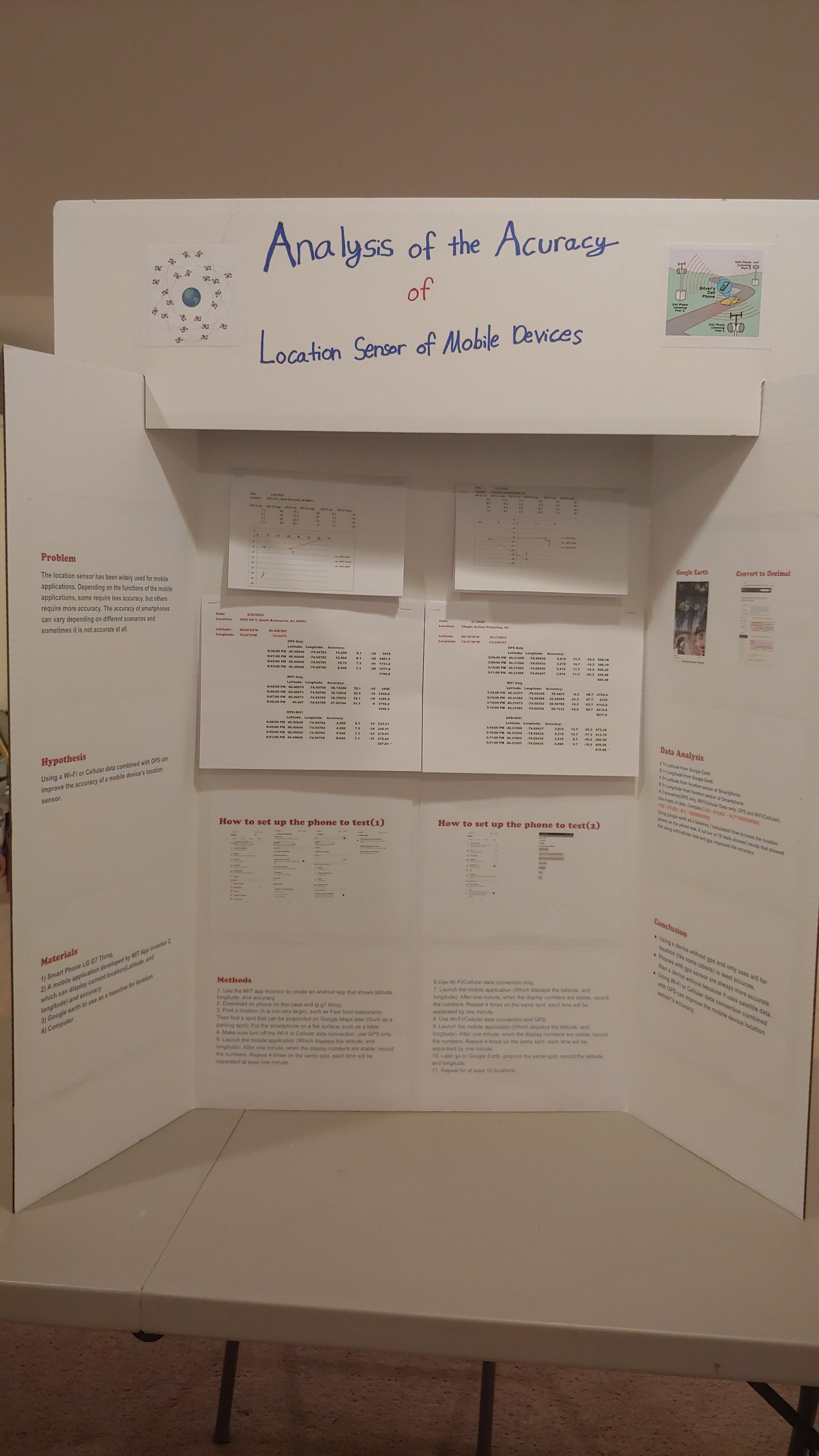Analysis the accuracy of location sensor of the mobile device
Abstract:
Mobile devices have changed our daily life. Mobile applications have been widely used on people’s mobile devices. The location sensor is an important function of the mobile device. It can help the user to navigate and track. The location sensor’s accuracy plays a very important role in the mobile application design. My project is to study and analyze different ways to use the location sensor on a mobile device, try to find the best way to use it which provides the most accuracy.
Bibliography/Citations:
No additional citationsAdditional Project Information
Project files
Research Plan:
Mercer County Science Fair Project Basic Research Plan
Analysis the accuracy of location sensor of the mobile device
By Edward Cao
Princeton Charter School
Due date 3/15/2020
A. Problem:
The location sensor has been widely used for mobile applications. Depend on the functions of the mobile applications, some require less accuracy, but others require more accuracy. Analyze the accuracy of the location sensor under different scenarios will help to design better mobile applications.
B. Hypothesis:
Using a Wi-Fi or Cellular data connection can improve the accuracy of a mobile device’s location sensor.
Research and study:
C. Procedure:
1. Materials:
1) Smart Phone LG G7 Thinq,
2) A mobile application developed by MIT App Inventor 2 , which can display current location(Latitude, and longitude)
2. Methodology:
Find easily identified locations, such as fast-food restaurants which collect location data (Latitude, and longitude). The data will be collected by four groups:
I: Only based on the mobile device’s location sensor (No Wi-Fi or No Cellular data connection, GPS only).
II. Only based on the Wi-Fi/ Cellular data connection.
III. Use Wi-Fi/ Cellular data connection and GPS.
IV. Go to Google Earth, pinpoint the location.
How to collect the data:
a) Find a location (It is not very large), such as Fast food restaurants. Then find a spot that can be pinpointed on Google Maps later (Such as a parking spot); Put the smartphone on a flat surface, such as a table.
b) Make sure turn off the Wi-fi or Cellular data connection, use GPS only.
c) Launch the mobile application (Which displays the latitude, and longitude). After two minutes, when the display numbers are stable, record the numbers. Repeat 4 times on the same spot, each time will be separated at least one minute.
d) Use Wi-Fi/Cellular data connection only;
e) Launch the mobile application (Which displays the latitude, and longitude). After two minutes, when the display numbers are stable, record the numbers. Repeat 4 times on the same spot, each time will be separated by one minute.
f) Use Wi-Fi/Cellular data connection and GPS;
g) Launch the mobile application (Which displays the latitude, and longitude). After two minutes, when the display numbers are stable, record the numbers. Repeat 4 times on the same spot, each time will be separated by one minute.
h) Later go to Google Earth, pinpoint the same spot, record the latitude, and longitude.
I) Repeat for at least 10 locations.
3. Analysis:
Use Google Earth as the baseline and compare data from each group of different locations.
D: Conclusion:
Using Wi-Fi or Cellular data connection and GPS can improve the mobile device location sensor’s accuracy.
A 1= Latitude from Google Earth
B 1= Longitude from Google Earth
A 2= Latitude from location sensor of Smartphone
B 2= Longitude from location sensor of Smartphone
In 3 scenarios(GPS only, WiFi/Cellular Data only, GPS and WiFi/Cellular):
Use 4 sets of data, Compare [ (A2 - A1)(A2 – A1)*10000000000 +(B2 - B1)(B2 – B1) *10000000000]
E. Benefits:
The result will help mobile application developers to design better applications involved in mobile device location sensors.
F: References:
1. Convert Degrees Minutes Seconds to/from Decimal Degrees:
https://www.fcc.gov/media/radio/dms-decimal
2. MIT App Inventor 2:
- Using the Location Sensor in mobile devices by using MIT App Inventor 2: https://appinventor.mit.edu/explore/content/location-sensor 1.
Abstract:
Mobile devices have changed our daily life. Mobile applications have been widely used on people’s mobile devices. The location sensor is an important function of the mobile device. It can help the user to navigate and track. The location sensor’s accuracy plays a very important role in the mobile application design. My project is to study and analyze different ways to use the location sensor on a mobile device, try to find the best way to use it which provides the most accuracy.

